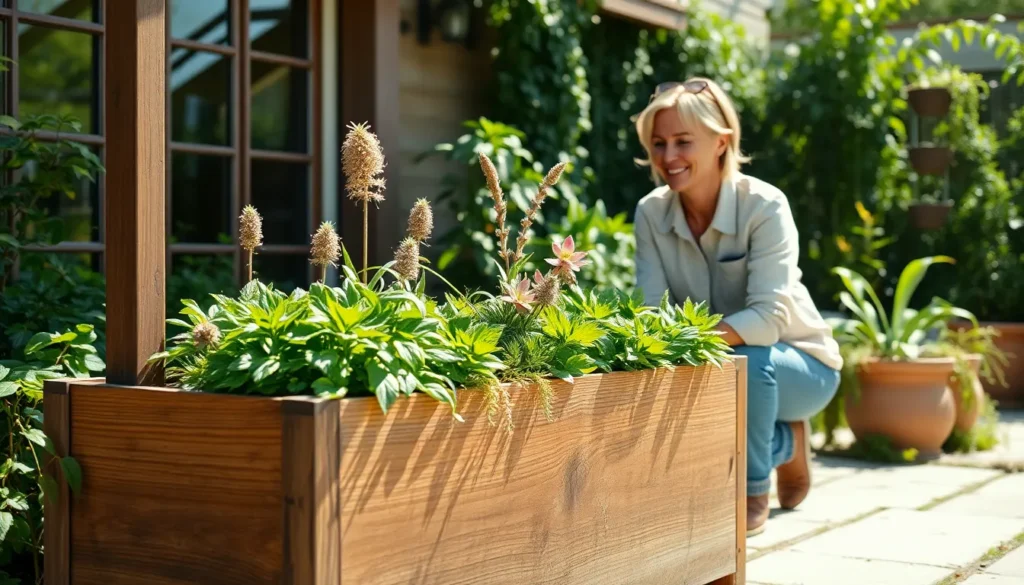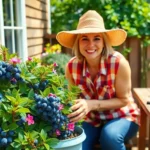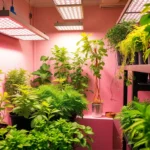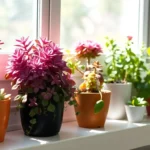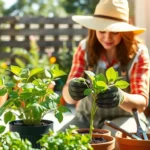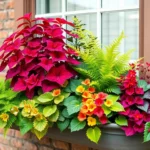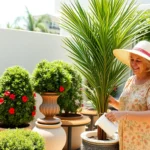When we think about the perfect planters for our green companions, wooden pots often get overlooked in favor of ceramic or plastic alternatives. Yet these natural beauties offer something special that synthetic materials simply can’t match – they breathe life into our spaces while providing exceptional growing conditions for our plants.
We’ve discovered that wooden planters aren’t just containers; they’re living ecosystems that work in harmony with plant roots. The natural porosity of wood allows for superior drainage and air circulation, preventing root rot while maintaining optimal moisture levels. Plus, they bring an organic warmth to any room that transforms ordinary plant displays into stunning focal points.
Whether you’re a seasoned gardener or just starting your plant journey, wooden pots offer versatility that adapts to any décor style. From rustic farmhouse charm to modern minimalist aesthetics, these timeless planters elevate both indoor and outdoor spaces while supporting healthier plant growth.
Choose the Right Wood Type for Your Plant Containers
Selecting the appropriate wood species transforms your wooden planters from simple containers into lasting investments for your garden. Different wood types offer varying levels of durability, cost effectiveness, and natural resistance to moisture and decay.
Hardwood Options for Durability
Hardwoods provide exceptional longevity for wooden pots that face constant moisture exposure. Cedar stands as our top recommendation because it contains natural oils that repel insects and resist rot for decades without treatment. Teak offers premium durability with its high oil content and tight grain structure that naturally weatherproofs your plant containers.
Redwood delivers impressive moisture resistance while maintaining a beautiful reddish color that ages gracefully in outdoor environments. Oak presents another solid hardwood choice though it requires proper sealing to prevent water damage over time. Cypress combines affordability with natural decay resistance making it perfect for gardeners seeking long lasting wooden planters without premium pricing.
Premium hardwoods like teak can cost 3 to 5 times more than softwood alternatives but typically last 15 to 25 years in outdoor conditions.
Softwood Alternatives for Budget-Friendly Choices
Softwoods offer accessible entry points into wooden plant containers without sacrificing basic functionality. Pine represents the most economical option for indoor wooden pots where moisture exposure remains minimal. Fir provides slightly better durability than pine while maintaining budget friendly pricing for beginning gardeners.
Spruce works well for temporary or seasonal wooden planters due to its lightweight nature and easy workability. Cedar fence boards offer another cost effective softwood solution that combines affordability with natural weather resistance. We recommend softwoods primarily for protected environments or short term planting projects.
Softwood containers typically cost 40% to 60% less than hardwood equivalents but may require replacement every 3 to 7 years depending on environmental conditions.
Treated vs. Untreated Wood Considerations
Untreated wood maintains its natural properties while allowing beneficial air exchange between soil and atmosphere. Natural wooden pots enable healthy root development without introducing chemicals into your growing environment. We prefer untreated options for edible plants including herbs, vegetables, and fruit bearing species.
Pressure treated lumber extends lifespan significantly but contains chemicals that can leach into soil over time. Modern copper based treatments pose fewer health risks than older arsenic formulations but still require consideration for food producing plants. Treated wooden planters work best for ornamental plants where chemical concerns remain minimal.
Heat treated wood offers a chemical free alternative that increases durability through high temperature processing. This treatment method kills insects and fungi without introducing foreign substances into your wooden containers. We recommend heat treated options when you need enhanced durability without chemical additives for your plant containers.
Consider Size and Drainage Requirements
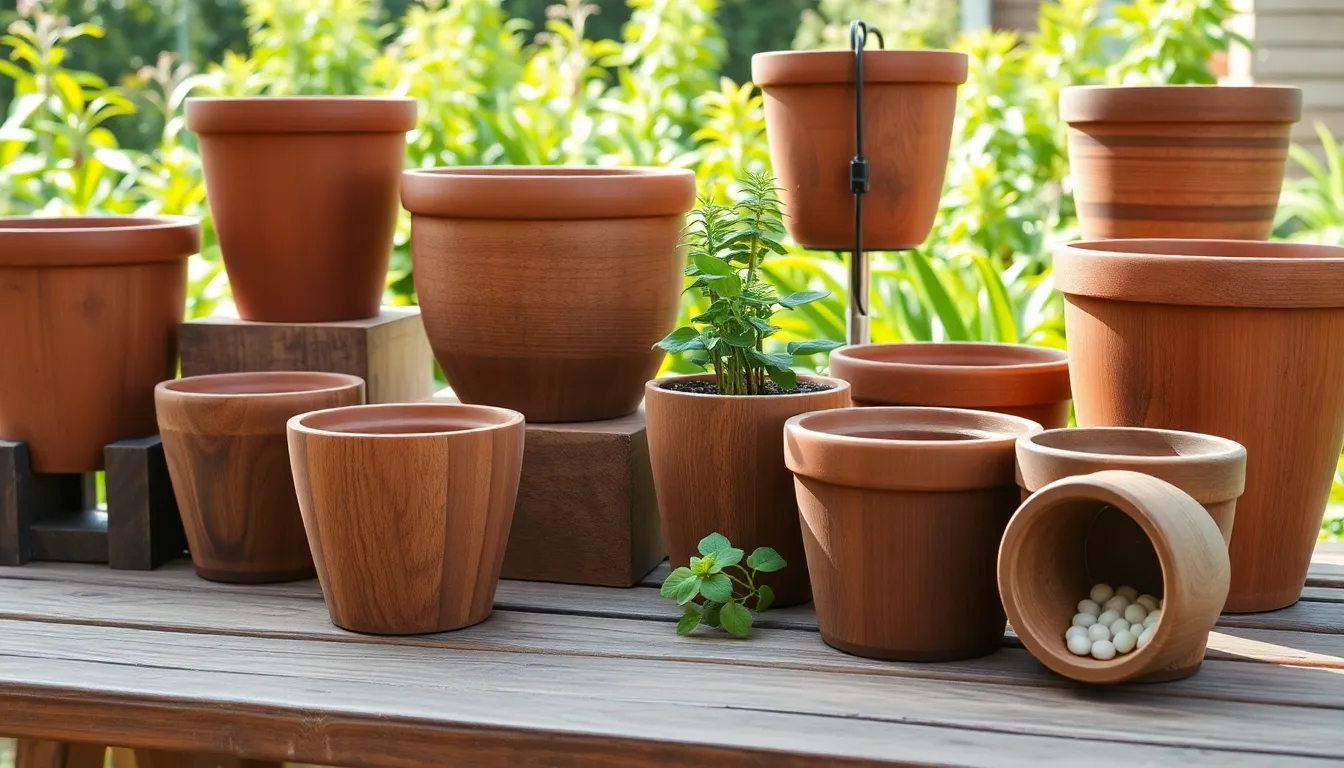
Selecting the right wooden pot for your plants involves two critical factors: proper sizing and effective drainage management. We’ll explore these essential elements to ensure your plants thrive in their wooden containers.
Measuring Your Plants’ Root Systems
Measure your plant’s root system before purchasing any wooden planter to ensure optimal growth conditions. We recommend choosing a pot that’s a few inches wider and deeper than the existing root ball, giving roots adequate space to expand naturally. This measurement prevents cramping and allows for healthy root development over time.
Consider the plant’s mature size when selecting wooden containers for long term growth. Fast growing plants like tomatoes or peppers need larger pots initially, while slow growing succulents can start in smaller containers. We suggest measuring both the current root spread and researching the plant’s expected growth pattern to make informed sizing decisions.
Account for soil depth requirements based on your exact plant varieties. Deep rooted plants like carrots or dahlias need wooden pots with substantial depth, while shallow rooted herbs like basil thrive in wider, less deep containers. Root bound plants will struggle regardless of wooden pot quality, so proper sizing remains crucial for plant health.
Creating Proper Drainage Holes
Drill drainage holes in your wooden planters since solid wood construction naturally prevents water escape. We recommend exact hole quantities based on planter dimensions to ensure proper water flow and prevent root rot.
| Planter Size | Recommended Drainage Holes |
|---|---|
| 6 inches or smaller | 1 hole minimum |
| 36 inch planter | 3-4 holes |
| 46 inch planter | 4-6 holes |
Position holes strategically across the bottom surface rather than clustering them in one area. We space drainage holes evenly to promote uniform water distribution and prevent soil from washing away through concentrated drainage points. Tall, narrow wooden planters need fewer holes than wide, shallow ones to maintain proper moisture levels.
Size your drainage holes appropriately using a drill bit between 1/4 inch and 1/2 inch diameter. Smaller holes may clog with soil particles, while larger openings allow too much soil to escape. We test drainage flow by pouring water into the empty wooden pot and observing how quickly it exits.
Adding Drainage Layers
Create drainage layers at the bottom of wooden pots using materials like gravel, pebbles, or broken pottery shards. This layer prevents soil from becoming waterlogged and improves overall root health by facilitating water movement away from plant roots.
Install industry fabric over your drainage layer to separate it from the soil above. We use this barrier to prevent soil particles from filtering down and clogging the drainage materials while still allowing water to pass through freely. This technique works particularly well in wooden planters where small gaps between boards might allow soil to escape.
Elevate wooden planters on feet or blocks to enhance airflow underneath and improve drainage effectiveness. We position these supports to create space between the planter bottom and the ground, preventing water accumulation that could lead to wood rot. This elevation also protects wooden surfaces from moisture damage and extends the planter’s lifespan.
Monitor drainage performance regularly by checking how quickly water flows from your wooden pots after watering. Proper drainage should allow excess water to exit within minutes, not hours. We adjust watering schedules based on how well our drainage systems perform with different plant varieties and seasonal conditions.
Evaluate Weather Resistance and Longevity
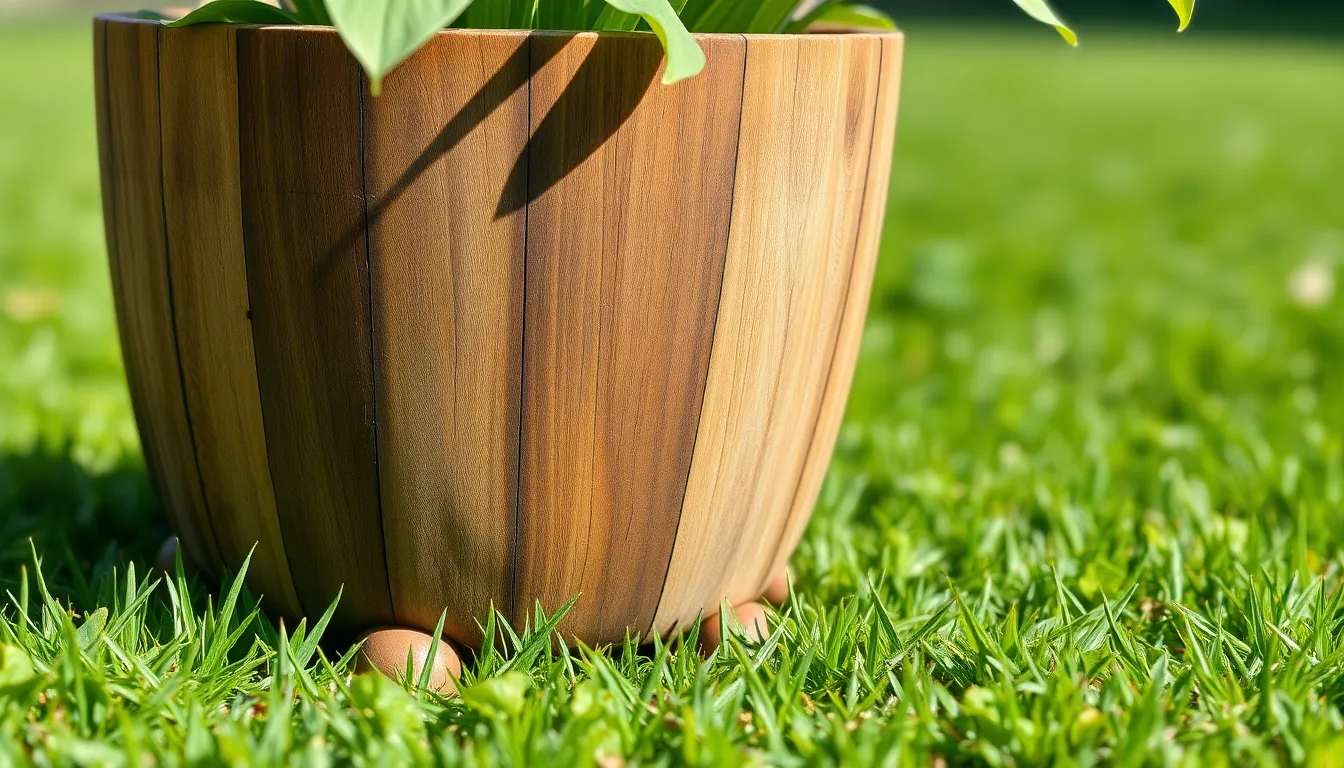
Understanding how wooden pots perform in various weather conditions helps us make informed decisions about long-term plant container investments. Selecting naturally durable wood species and implementing proper maintenance practices ensures our wooden planters withstand outdoor elements for years to come.
Natural Wood Preservation Methods
Chemical-free oils like linseed oil penetrate deep into wood fibers and maintain moisture balance while protecting against weather damage. We recommend applying these natural treatments annually, especially for pots exposed to harsh outdoor conditions. Regular oil applications help preserve the wood’s natural appearance and extend durability significantly.
Allowing wood to naturally patinate develops character over time as exposure to sunlight, wind, and water creates unique color changes. This aging process doesn’t compromise structural integrity when we maintain proper oil treatments. Natural patination actually indicates healthy wood weathering rather than deterioration.
Elevating wooden pots off the ground improves air circulation and drainage, preventing moisture buildup that leads to rot. We suggest using pot feet or placing containers on blocks to enhance airflow around the base. This simple technique dramatically extends planter lifespan by reducing contact with standing water.
Protective Finishes and Sealants
Waterproof sealants create protective barriers against UV rays and moisture absorption, slowing down wood’s natural water uptake. These finishes reduce swelling, cracking, and rot by maintaining consistent moisture levels within the wood structure. We find that quality sealants can double the lifespan of outdoor wooden planters.
Stains combined with protective oils offer both aesthetic enhancement and weather resistance for exposed wooden containers. Regular reapplication every 12-18 months maintains optimal protection levels. Sanding rough areas before applying new finishes ensures proper adhesion and maximum effectiveness.
Monitoring finish condition helps us identify when resealing becomes necessary to maintain weather protection. Fading or worn areas indicate it’s time for maintenance attention. Prompt reapplication prevents water damage from penetrating vulnerable wood surfaces.
Signs of Wear to Monitor
Wood discoloration beyond normal patina signals potential water damage requiring immediate attention. We watch for unusual darkening or black spots that indicate moisture problems. Early intervention prevents minor issues from becoming major structural damage.
Cracks or splits in wood surfaces create entry points for water and insects, compromising container integrity. Regular inspection helps us identify these problem areas before they expand. Filling small cracks with wood filler and resealing prevents further deterioration.
| Warning Signs | Indicates | Action Required |
|---|---|---|
| Soft, spongy areas | Rot or decay | Sand and reseal |
| Insect holes | Pest infestation | Treat and protect |
| Peeling finishes | Coating failure | Strip and refinish |
Soft, spongy wood areas signal advanced rot or decay that requires aggressive treatment. We test suspicious spots by pressing firmly to check for structural weakness. Catching these problems early allows for repair rather than replacement.
Insect infestation signs like small holes or sawdust piles indicate pest activity that can destroy wooden containers. Regular monitoring helps us spot these issues before important damage occurs. Professional treatment may become necessary for severe infestations.
Compare Costs Between Wood Types and Sizes
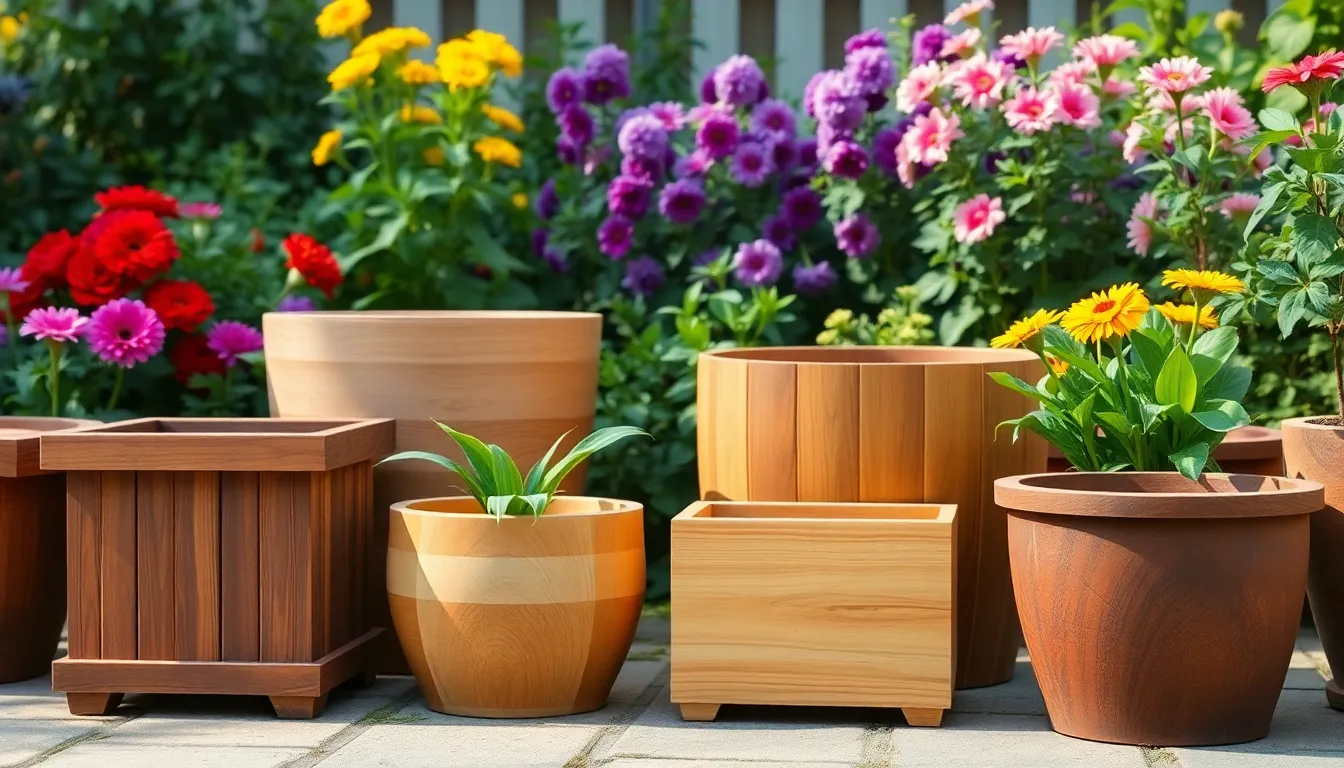
Understanding the price variations between different wood types and sizes helps us make informed decisions when selecting wooden planters for our gardening projects.
Budget-Friendly Cedar Options
Cedar stands out as our most cost-effective choice for outdoor wooden planters due to its natural resistance to decay and insects. Budget cedar planters typically range from $40 to $90 depending on size and complexity, making them accessible for most gardening budgets.
Foldable cedar raised beds offer excellent value at approximately $44, while simple cedar planter boxes stay under $100. These affordable options provide the durability we need for outdoor use without very costly.
Smaller cedar planters measuring 21 inches by 9 inches cost around $20 to $40, perfect for compact spaces or herb gardens. The natural weather resistance of cedar means we won’t need frequent replacements, maximizing our investment over time.
Premium Hardwood Investments
Premium hardwoods like teak and redwood command significantly higher prices but deliver superior durability and aesthetic appeal. These investments often cost double or triple the price of budget cedar options, with large premium hardwood planters starting at $130 and extending well beyond that range.
Designer hardwood planters can cost several hundred dollars, reflecting their exceptional craftsmanship and longevity. These premium options weather gracefully outdoors, developing an attractive patina that enhances their natural beauty over time.
Large wooden whiskey barrel planters made from premium hardwoods around 26 inches in diameter and 17.5 inches high range from $130 to over $300. The substantial price difference reflects the superior materials and specialized construction techniques used in these high-end planters.
DIY vs. Store-Bought Price Differences
DIY wooden planters offer important cost savings when we have access to affordable wood and basic woodworking skills. Raw cedar planks for DIY projects typically cost less than finished commercial products since we’re only paying for materials and tools.
Store-bought wooden planters provide convenience and uniform quality but include labor costs, finishing work, and retail markups. These ready-to-use options range from $20 for small pots to over $300 for large or multi-tiered sets, reflecting the added value of professional craftsmanship.
Commercial planters often include beneficial features like pre-drilled drainage holes, built-in stands, or specialized finishes that would require additional time and expertise in DIY projects. Retailers like Lowe’s, Home Depot, and specialized online stores offer extensive selections with consistent quality standards we can rely on for our gardening needs.
Assess Maintenance Requirements for Different Woods
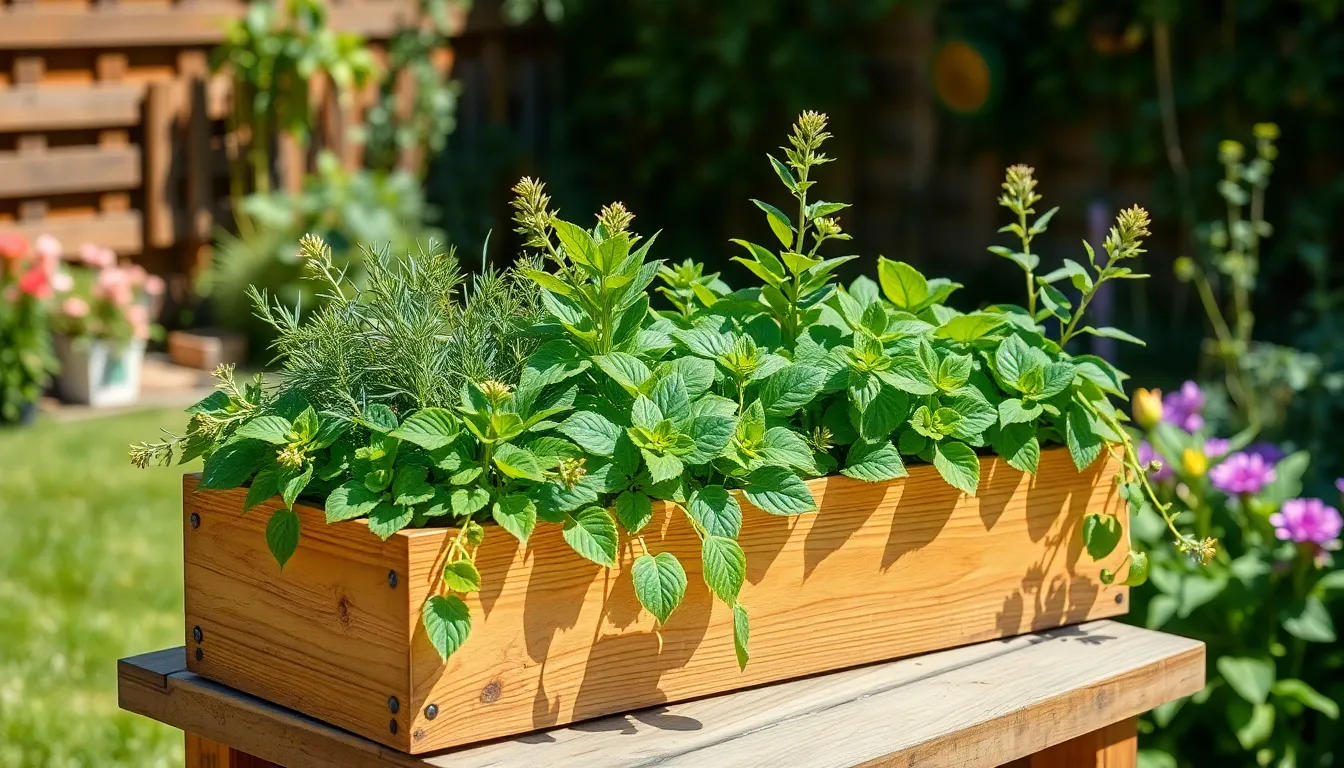
Different wood types demand exact maintenance approaches to keep your wooden planters thriving. Understanding these requirements helps us maximize the lifespan of our investments while maintaining optimal growing conditions for plants.
Regular Cleaning and Care Routines
Empty planters completely before starting any cleaning routine to prevent mold and rot from establishing in soil residue. Remove all plants, soil, and debris to access every surface that needs attention.
Clean surfaces using mild soap and warm water with a soft brush to eliminate dirt and grime without damaging the wood fibers. This gentle approach preserves the natural texture while removing harmful buildup that can accelerate decay.
Apply chemical-free wood oil annually to maintain your planters’ natural feel and weather resistance. These protective treatments enhance appearance while creating a barrier against moisture damage and UV exposure.
Check drainage holes regularly to ensure proper water flow throughout the growing season. Clear any blockages immediately to prevent waterlogging that can cause rapid wood deterioration and root problems.
Inspect for early signs of wear during routine maintenance to catch minor issues before they become major repairs. Look for surface cracks, loose joints, or areas where the protective finish appears thin or damaged.
Seasonal Maintenance Tasks
Perform thorough spring cleaning and inspection before planting season begins to identify any winter damage and prepare surfaces for new protective treatments. This timing ensures optimal conditions for both plants and planters.
Move pots to sheltered locations during wet seasons or harsh winter weather to minimize exposure to prolonged moisture and freeze-thaw cycles. Covered porches or garage spaces provide ideal protection while maintaining air circulation.
Assess structural integrity after winter by examining all surfaces for cracks, warping, or rot caused by temperature fluctuations. Address any damage immediately to prevent further deterioration during the growing season.
Reapply protective oil treatments in early spring when weather conditions allow proper absorption and curing. This seasonal refresh maintains the wood’s natural resistance to weather elements throughout the active growing period.
Ensure excellent drainage before winter storage by cleaning all holes and adding fresh drainage materials if needed. Proper preparation prevents ice damage and standing water issues during dormant periods.
When to Replace vs. Repair
Repair planters with minor surface damage such as small cracks or worn finishes by sanding affected areas and reapplying protective oil or sealant. These issues typically respond well to basic maintenance without requiring complete replacement.
Replace extensively rotted or warped planters that show structural compromise, as these conditions can affect both plant health and safety. Severely damaged wood cannot provide adequate support or drainage for healthy plant growth.
Evaluate the cost effectiveness of repairs versus replacement based on the extent of damage and the planter’s original value. Sometimes investing in a new planter proves more economical than extensive repair work.
Consider the wood type’s natural lifespan when making replacement decisions, as some species like cedar and teak naturally last longer than others. Premium woods often justify repair efforts due to their superior longevity and continued performance.
Monitor drainage performance as a key indicator for replacement timing, since compromised drainage affects plant health regardless of the planter’s appearance. Proper water flow remains essential for successful container gardening.
Match Wood Pot Styles to Your Garden Aesthetic
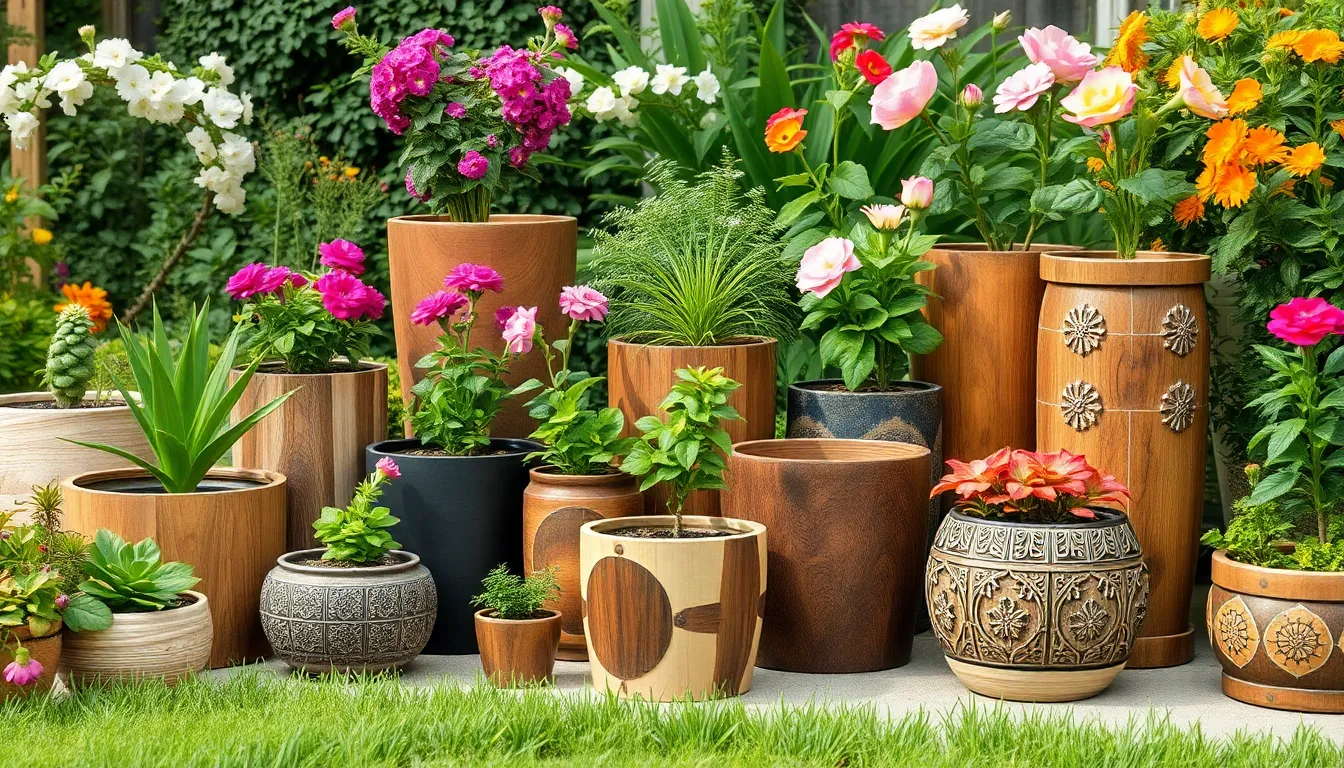
Selecting wooden pots that complement your garden’s design creates visual harmony while maintaining the practical benefits we’ve discussed. Different wood pot styles enhance exact garden aesthetics through their unique textures, finishes, and design elements.
Rustic and Natural Designs
Rustic wooden pots showcase natural wood finishes and rough textures that bring authentic charm to country style gardens. These planters feature untreated or lightly stained wood that displays organic grain patterns and natural knots, creating an effortless connection with wildflower gardens and informal planting schemes.
Sturdy, simple shapes define rustic wooden containers, making them perfect companions for earthy tones and handcrafted garden elements. Natural cedar and reclaimed wood options work particularly well for this aesthetic, as their weathered appearance develops character over time without losing structural integrity.
Country gardens benefit from these unrefined wooden pots because they blend seamlessly into natural landscapes. The organic textures complement stone pathways, wooden fences, and cottage garden plants like lavender, herbs, and climbing roses.
Modern and Minimalist Options
Modern wooden planters feature clean lines and smooth surfaces that enhance contemporary garden designs with sophisticated simplicity. Geometric forms, monochrome finishes in black or grey, and sleek bamboo materials create refined focal points for minimalist outdoor spaces.
Contemporary gardens thrive with these streamlined wooden containers because they provide functional benefits like superior drainage while maintaining visual restraint. Treated wood options ensure weather resistance without compromising the clean aesthetic that modern landscapes require.
Patio areas and indoor spaces with modern décor particularly benefit from these understated wooden pots, as they offer natural warmth without overwhelming architectural elements. Square and rectangular shapes work especially well for creating organized, symmetrical plant displays.
Decorative Carved and Painted Styles
Artistic wooden pots with intricate carvings and vibrant painted patterns serve as both plant containers and ornamental garden features. Floral motifs, geometric designs, and culturally inspired artwork transform these planters into conversation pieces that brighten any outdoor space.
Painted wooden containers offer endless customization possibilities, allowing you to match seasonal color schemes or complement exact flowering plants. Bright colors and unique artistry personalize garden spaces while maintaining the natural benefits of wood construction.
Cultural garden themes particularly benefit from these decorative wooden pots, as carved patterns can reflect Mediterranean, Asian, or traditional American design elements. These ornamental planters work well as statement pieces in formal gardens or as accent features in eclectic industry designs.
Select Appropriate Plants for Wooden Containers
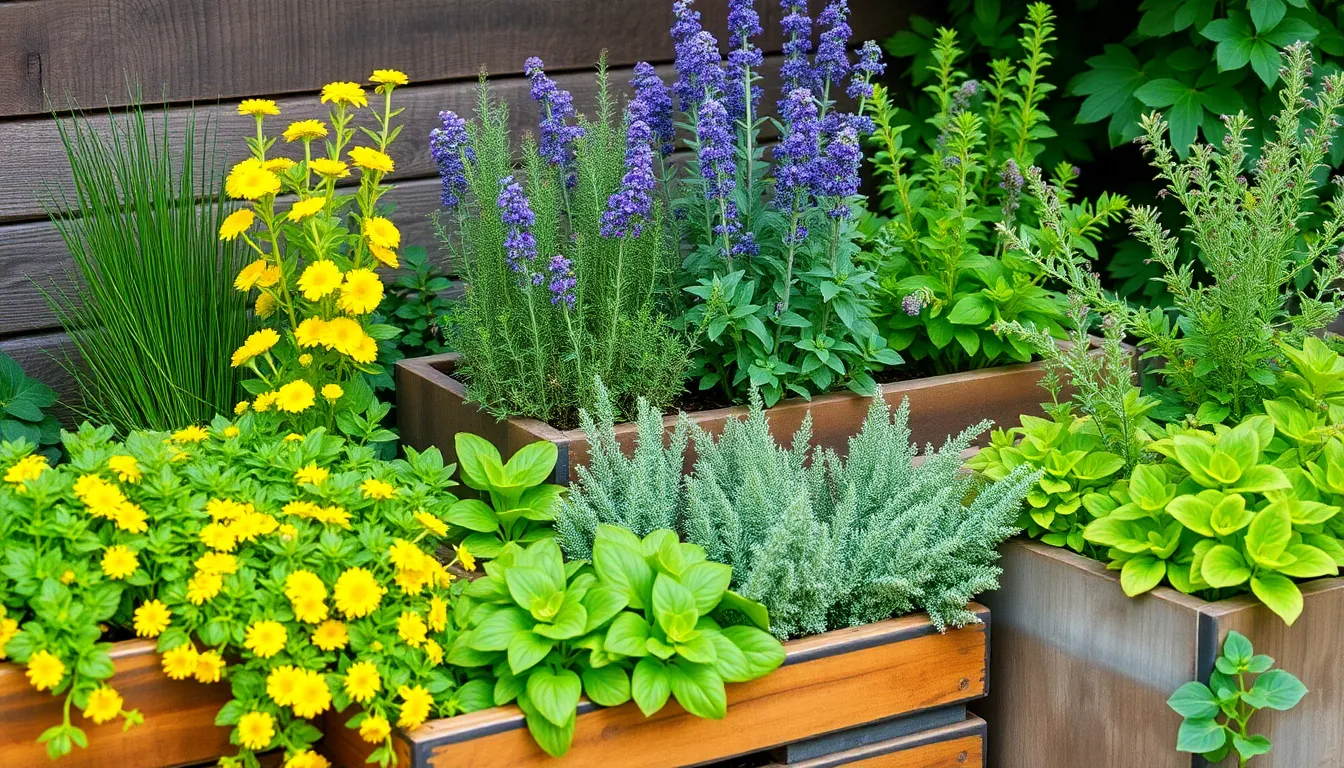
Choosing the right plants makes all the difference when using wooden containers for your garden. We’ve found that wooden pots offer natural insulation and excellent moisture retention properties that benefit exact plant types while challenging others.
Moisture-Loving Plants That Thrive
Golden Creeping Jenny (Lysimachia nummularia ‘Aurea’) cascades beautifully over wooden pot rims and absolutely loves the consistent moisture that wood provides. This stunning plant thrives in partial shade while benefiting from the stable moisture environment that wooden containers naturally maintain.
Japanese Pieris (Pieris japonica) delivers year-round beauty with its colorful new growth and showy flowers. We recommend this evergreen shrub because it tolerates conditions from full sun to shade and appreciates the balanced soil moisture that wooden pots offer.
Herbs like mint and parsley flourish in wooden containers since these plants need consistent moisture without temperature extremes. These culinary favorites benefit from wood’s natural insulating properties that prevent rapid soil temperature fluctuations.
Begonia, impatiens, and coleus perform exceptionally well in wooden pots due to their moisture requirements. These popular flowering plants appreciate the moisture-retentive qualities of wood while thriving in shaded or semi-shaded locations where wooden containers excel.
Drought-Tolerant Options
Lavender stands out as a classic container gardening choice that adapts well to wooden pots with proper drainage. This fragrant herb prefers well-drained soil and full sun conditions, making it perfect for wooden containers when we ensure adequate drainage holes.
Rosemary and thyme bring Mediterranean charm to wooden planters while tolerating drier growing conditions. These hardy herbs thrive in containers with good drainage and can handle the occasional dry spell that might occur in wooden pots during hot weather.
Yucca ‘Golden Sword’ provides architectural interest with its sword-like leaves and remarkable resilience. This durable plant handles various light conditions and adapts well to the soil volume limitations of wooden containers.
Plants to Avoid in Wood Pots
Plants requiring consistently waterlogged soil can cause premature decay of wooden containers while developing root rot problems. We avoid these plants because constantly soggy conditions damage both the wooden structure and plant health over time.
Large, heavy-rooted trees and shrubs typically outgrow wooden containers quickly and stress the pot’s structural integrity. These plants need extensive root space that exceeds what most wooden containers can provide long-term.
Plants sensitive to root disturbance or requiring extreme soil pH levels may struggle in wooden pots that can gradually alter soil chemistry. We skip these finicky plants since wooden containers work best with adaptable species that tolerate moderate growing conditions.
Position Your Wooden Planters for Optimal Growth
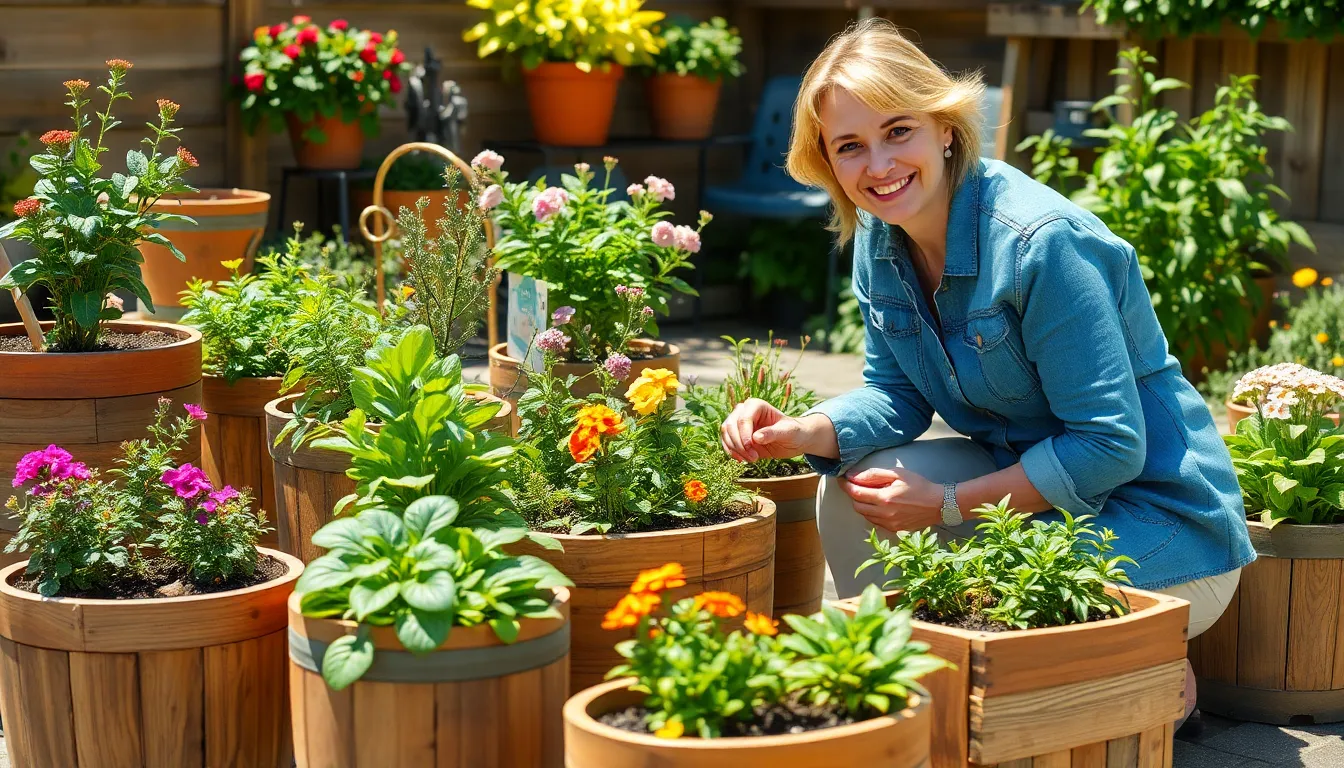
Strategic placement transforms your wooden planters from simple containers into thriving plant ecosystems. We’ll guide you through key positioning factors that maximize both plant health and your planter’s longevity.
Sun and Shade Considerations
Assess your space’s sunlight patterns throughout the day since different plants require varying light levels for optimal growth. Leafy greens and herbs like lettuce, kale, parsley, and mint thrive in partial shade or morning sun environments. Fruiting plants such as tomatoes, peppers, and squash demand 6 to 8 hours of full sun daily to produce abundant harvests.
Match plant types to your location’s sunlight conditions to maximize growth and flowering potential. We recommend observing light patterns in your chosen area for several days before selecting plants. Morning sun locations work perfectly for delicate herbs that might wilt in intense afternoon heat. South-facing positions receive the most consistent sunlight for sun-loving vegetables and flowers.
Track sunlight movement in your garden or indoor area to place wooden pots where plants receive appropriate light exposure. Seasonal changes affect light availability, so position planters where they can be easily moved if needed. East-facing locations provide gentle morning light, while west-facing spots deliver intense afternoon sun that benefits heat-loving plants.
Protection from Extreme Weather
Wooden pots provide natural insulation that protects plant roots from rapid temperature changes, though they remain vulnerable to extreme weather conditions. During harsh sun exposure, wooden planters dry out quickly and require mulching plus frequent watering to retain soil moisture. We suggest adding 2-3 inches of organic mulch to wooden containers in hot climates.
Shield your planters during cold weather by moving them indoors or to sheltered areas, preventing damage and root freeze in sensitive plants. Wooden planters offer some cold protection, but prolonged freezing temperatures can crack both wood and soil. Wrapping planters with insulating materials or grouping them together creates additional warmth during winter months.
Monitor weather forecasts and prepare protective measures before extreme conditions arrive. Strong winds can topple tall wooden planters, so secure them against structures or use plant stakes for stability. Heavy rain can oversaturate wooden containers, making proper drainage essential year-round.
Indoor vs. Outdoor Placement
Outdoor wooden planters require careful attention to drainage and sun exposure based on your exact plant selection. Consider your planter’s material durability against continuous rain and UV exposure when choosing permanent outdoor locations. Elevating outdoor planters on feet or blocks enhances airflow and prevents moisture damage to both wood and surrounding surfaces.
Indoor wooden pot placement focuses on maximizing natural light while maintaining stable environmental conditions. Position containers near windows with sufficient sunlight but away from heating vents or cold drafts that create temperature fluctuations. We recommend south or west-facing windows for most indoor plants in wooden containers.
Choose locations based on root depth requirements, sunlight needs, and your exact climate conditions. Shallow-rooted plants fit smaller wooden pots placed on tabletops or shelves, while deep-rooted plants need larger boxes positioned directly on floors or sturdy plant stands. Whether inside or outside, ensuring optimal conditions for light, moisture, and protection promotes plant health while maximizing your wooden planters’ aesthetic value.
Prepare and Set Up Your Wooden Plant Containers
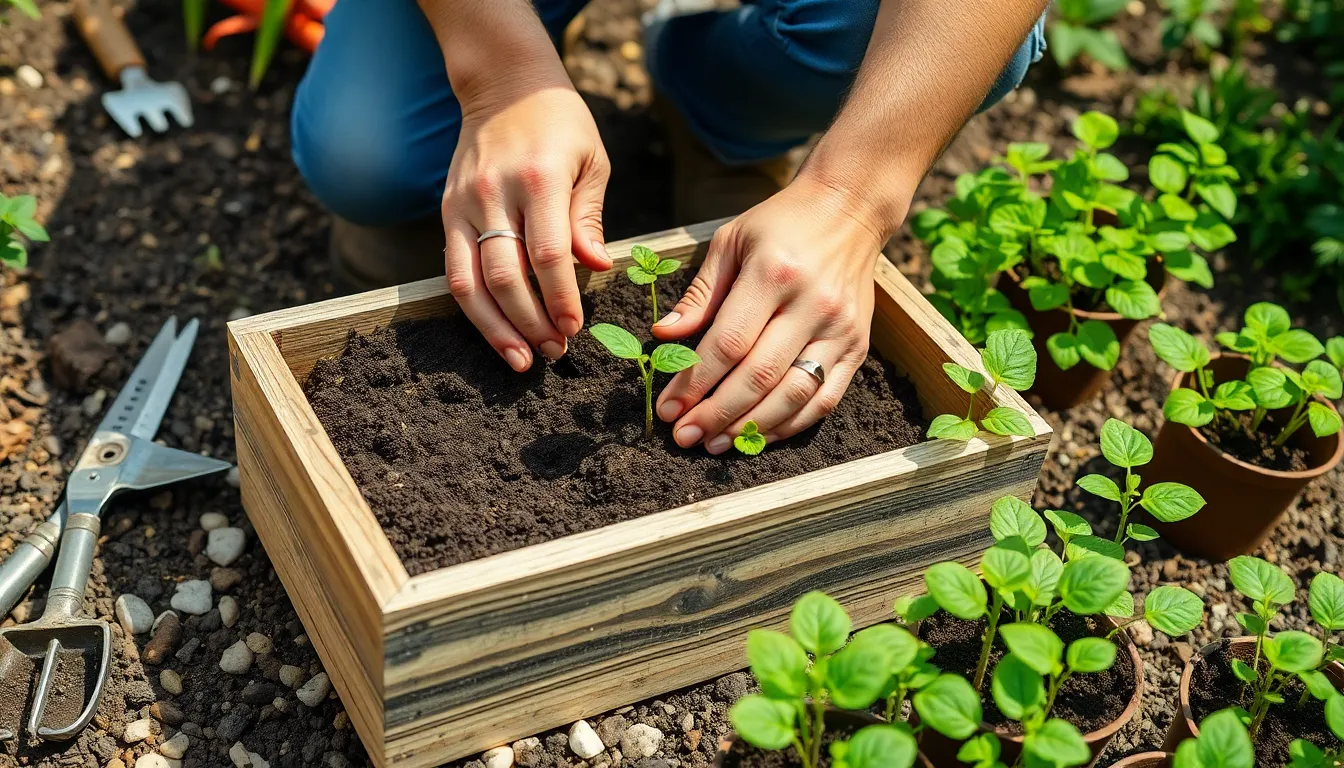
Now that we’ve selected our wooden planters and positioned them strategically, it’s time to prepare them properly for planting. The success of our wooden container gardens depends heavily on three critical preparation steps.
Soil Selection and Preparation
Use high-quality potting soil that balances drainage with moisture retention for optimal plant health. We recommend creating a soil mix containing compost, peat moss (or coconut coir), and perlite or vermiculite to achieve the perfect growing medium. This combination provides the nutrients our plants need while preventing waterlogging issues common in wooden containers.
Avoid garden soil directly as it compacts easily and retains excessive moisture in container environments. Garden soil may also harbor pests or diseases that can damage both our plants and wooden planters. Instead, we should invest in commercial potting mixes specifically designed for container gardening.
Moisten the soil mix slightly before planting to help it settle properly around plant roots. This preparation step ensures our soil supports healthy root development from day one. We can test the moisture level by squeezing a handful of soil – it should hold together loosely without dripping water.
Initial Planting Techniques
Place a thin layer of gravel or small stones at the bottom of our wooden planters for enhanced drainage. This drainage layer prevents water from pooling at the bottom and causing root rot or wood deterioration. We typically use about one inch of drainage material for most planter sizes.
Fill with prepared soil mix up to approximately 2-3 inches below the planter rim to allow adequate watering space. This measurement ensures we have room for thorough watering without soil spillover. Proper soil level also prevents water from sitting against the wooden rim where it could cause premature decay.
Position plants carefully by gently removing them from their nursery containers and loosening any root bound sections. We should ensure each plant’s root system has sufficient space to spread without crowding neighboring plants. Firmly pack soil around the roots to eliminate air pockets that could hinder growth.
Leave adequate spacing between plants to promote healthy air circulation and prevent disease development. Most herbs need 6-8 inches of space, while larger plants like Japanese Pieris require 12-18 inches. Proper spacing allows each plant to receive optimal light and nutrients from our carefully prepared soil.
Watering Schedule Establishment
Water thoroughly immediately after planting until water drains freely from the bottom drainage holes. This initial watering settles the soil around plant roots and activates the nutrients in our potting mix. We should continue watering until we see consistent drainage, indicating the soil is properly saturated.
Check soil moisture daily during warm weather since wooden containers dry out faster than ground beds or plastic pots. The porous nature of wood allows moisture to evaporate through the container walls, requiring more frequent watering than other container types. We can test moisture levels by inserting our finger about one inch into the soil surface.
Water when the top inch of soil feels dry to the touch, typically every 1-2 days in hot weather. This schedule prevents both underwatering and overwatering, which can lead to root rot in wooden containers. During cooler or humid conditions, we may need to water less frequently, perhaps every 3-4 days.
Increase watering frequency during hot, windy conditions when evaporation rates accelerate significantly. Wind and heat can quickly dry out wooden planters, requiring twice daily watering for some plants like Golden Creeping Jenny. We should adjust our schedule based on weather patterns and individual plant needs.
Monitor Plant Health in Wooden Environments
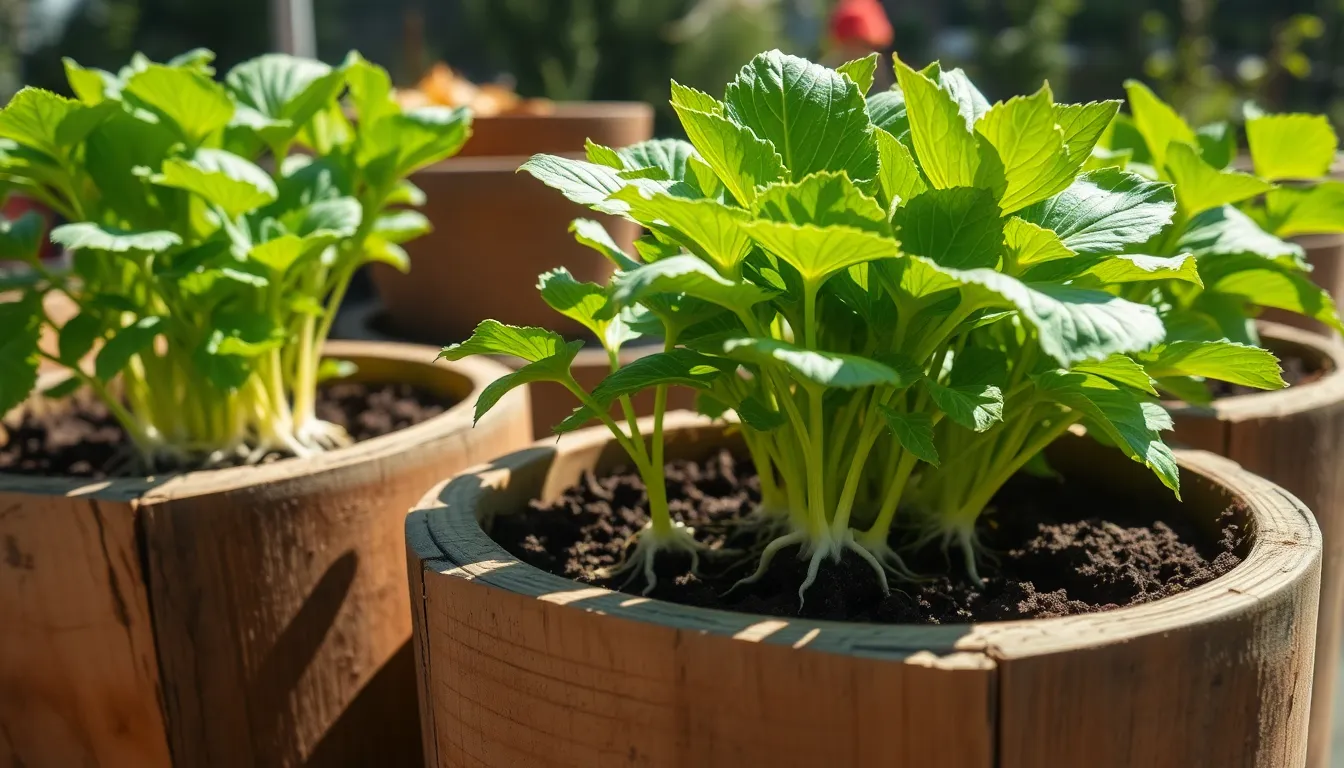
We’ve established our wooden planters and planted our chosen varieties, but ongoing observation remains crucial for plant success. Regular monitoring helps us catch problems early and maintain the optimal growing conditions that wooden containers provide.
Signs of Healthy Root Development
White or light tan roots indicate thriving plants in wooden environments. We should look for firm, evenly distributed roots throughout the soil when we occasionally check beneath the surface. Healthy root systems in wooden pots avoid circling patterns that signal root binding issues.
Robust plant vigor demonstrates successful root establishment in wooden containers. New leaf development appears consistently when roots access the improved aeration that wood’s natural porosity provides. We’ll notice stable soil moisture levels without waterlogging as another positive indicator.
Strong root respiration occurs naturally in wooden pots due to their breathable structure. This enhanced oxygen exchange supports root growth and prevents the anaerobic conditions that damage plant health. We can observe this through consistent plant growth and vibrant foliage color.
Common Issues and Answers
Rot and decay present the primary challenge with wooden plant containers. Continuous exposure to soil moisture can deteriorate wood over time, especially without proper protection. We address this by applying sealants or stains that improve water resistance and extend pot lifespan.
Drainage problems compound moisture issues in wooden planters. We ensure adequate drainage holes prevent waterlogged soil that accelerates wood decay. Regular inspection of drainage systems helps us maintain optimal moisture levels.
Maintenance demands require more attention than plastic alternatives. Periodic checks for insect damage, fungal growth, and weathering protect our investment. We reapply protective coatings annually and clean pots regularly to maintain wood integrity.
Weight considerations affect portability of larger wooden containers. While generally lightweight, substantial planters become heavy when filled with soil and water. We choose quality, sustainably sourced wood and consider reinforcing designs for frequently moved containers.
Seasonal Care Adjustments
Winter protection utilizes wood’s natural insulating properties to shield roots from freezing. We add mulching or covering in extremely cold climates to prevent freeze thaw damage. The wood’s insulation regulates soil temperature better than plastic or ceramic alternatives.
Summer monitoring requires increased attention to moisture levels. Wood’s breathability helps moderate soil temperature during hot weather but can lead to faster drying. We check soil moisture more frequently and water accordingly without overwatering.
Year round maintenance involves vigilant inspection for structural issues. We monitor for rot signs or insect activity, especially after wet seasons or heavy rainfall. Maintaining sealants and protective treatments ensures long term durability of our wooden plant containers.
Seasonal reapplication of protective coatings coincides with weather changes. We schedule maintenance before harsh weather seasons to maximize protection. This proactive approach prevents damage that would require expensive repairs or replacement.
Conclusion
We’ve explored how wooden pots transform ordinary container gardening into something extraordinary. These natural vessels offer unmatched benefits that synthetic alternatives simply can’t replicate – from superior root health to timeless aesthetic appeal.
The key to success lies in making informed choices about wood types durability requirements and proper maintenance routines. Whether you’re starting with budget-friendly cedar or investing in premium hardwoods the fundamentals remain the same: proper drainage thoughtful plant selection and consistent care.
Your wooden planters will reward your attention with years of beautiful growth and natural charm. They’ll age gracefully alongside your plants creating living partnerships that enhance any space. The investment in quality wooden containers pays dividends through healthier plants and enduring garden beauty that only improves with time.
Frequently Asked Questions
What are the main benefits of using wooden planters over plastic or ceramic pots?
Wooden planters offer superior drainage and air circulation due to their natural porosity, preventing root rot while maintaining optimal moisture levels. They create living ecosystems that promote healthy plant growth and add organic warmth to any space. Their versatility complements various décor styles from rustic to modern, making them ideal for both indoor and outdoor environments.
Which wood types are best for making durable planters?
Hardwoods like cedar, teak, redwood, oak, and cypress are recommended for their longevity and natural resistance to rot and moisture. These species offer excellent durability for outdoor use. For budget-friendly options, softwoods such as pine, fir, and spruce work well in less demanding environments, though they may require more maintenance.
Should I choose treated or untreated wood for my planters?
For edible plants, untreated wood is recommended to avoid introducing chemicals into the soil. Untreated wood maintains natural properties that benefit plant health. However, treated wood can extend lifespan in harsh outdoor conditions. Heat-treated wood offers a chemical-free alternative that enhances durability without compromising plant safety.
How do I determine the right size wooden planter for my plants?
Measure your plant’s root system and choose a pot that’s wider and deeper than the root ball. Consider the plant’s mature size and specific soil depth requirements. Allow adequate space for growth while ensuring the planter isn’t so large that it retains excess moisture, which could harm the plant.
How many drainage holes should I drill in wooden planters?
The number of drainage holes depends on planter size. Small planters (under 12 inches) need 3-5 holes, medium planters (12-24 inches) require 5-8 holes, and large planters (over 24 inches) need 8-12 holes. Space holes evenly across the bottom and drill them at least ½ inch in diameter for proper water flow.
What’s the best way to protect wooden planters from weather damage?
Apply chemical-free oils like linseed oil annually to maintain moisture balance and weather resistance. Use waterproof sealants for outdoor planters and reapply protective stains regularly. Monitor for signs of wear like discoloration or cracks, and address issues promptly. Elevate planters on feet or blocks to enhance airflow and prevent moisture damage.
How much do wooden planters typically cost compared to other materials?
Cedar planters offer budget-friendly options accessible to most gardening budgets, while premium hardwoods like teak and redwood require higher investment but provide superior durability. DIY wooden planters can significantly reduce costs compared to store-bought options, though commercial products offer convenience and consistent quality.
What plants work best in wooden containers?
Moisture-loving plants like Golden Creeping Jenny, Japanese Pieris, and various herbs thrive in wooden containers. These plants benefit from the moisture-retentive environment wooden pots provide. Avoid plants requiring consistently waterlogged soil, large-rooted trees, or those sensitive to root disturbance, as they can compromise the wooden pot’s integrity.
What type of soil should I use in wooden planters?
Use high-quality potting soil that balances drainage and moisture retention. A recommended mix includes compost, peat moss (or coconut coir), and perlite or vermiculite. Avoid garden soil as it tends to compact and may harbor pests. This mixture provides proper nutrients while maintaining the drainage benefits of wooden containers.
How often should I water plants in wooden planters?
Check soil moisture frequently, especially in warm weather, as wooden planters can dry out faster than other materials. Water when the top inch of soil feels dry, but avoid overwatering. The frequency depends on plant type, weather conditions, and planter size. Monitor plants closely during establishment to develop an appropriate watering schedule.

